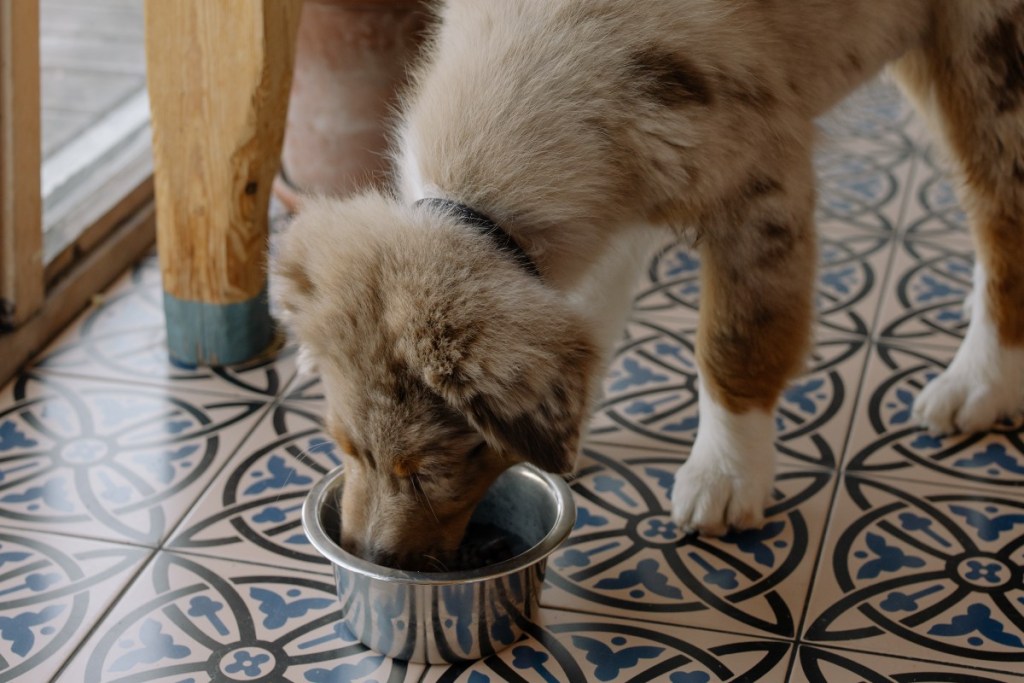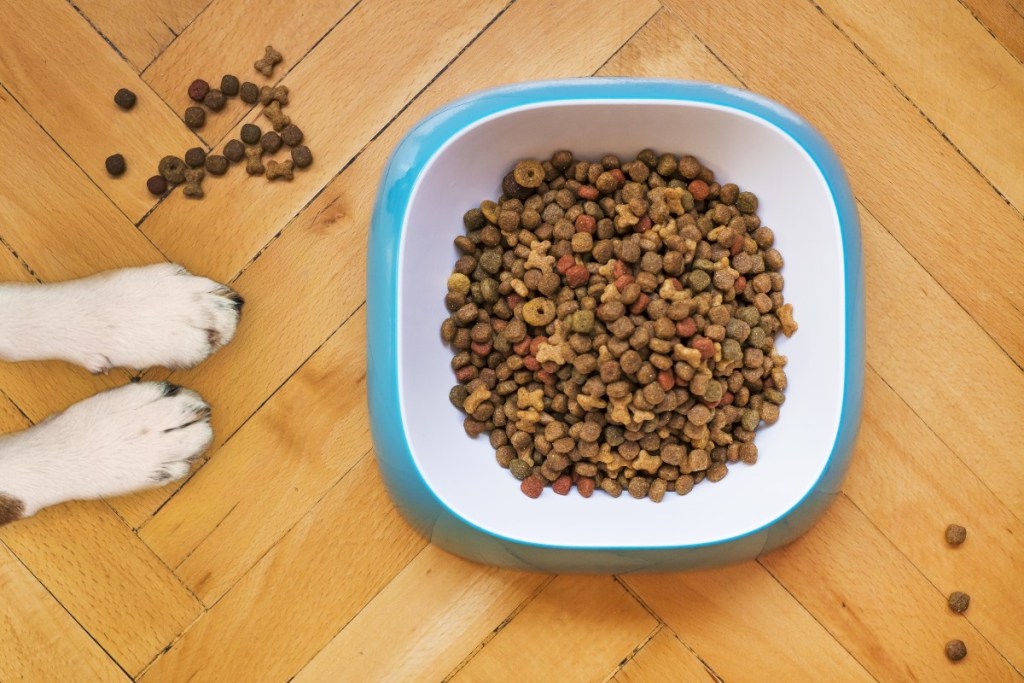All that kibble your puppy is eating is providing her with the building blocks she’ll need to live a long, healthy life. You may have researched several brands of pet foods and consulted your vet on the best grub for your little one. However, it’s not just what you feed your puppy—it’s how much you give.
How much food should a puppy eat, though? It’s not so cut and dry. During a dog’s first year of life, that amount changes constantly based on the animal’s age and weight. It’s likely not surprising that a Great Dane pup will need more fuel than a Chihuahua the same age.
Staying on top of these numbers can help your puppy grow from a little furball into a strong, healthy dog. Consider this your quick-and-easy guide.

How much food should a puppy eat a day?
It’s important to note this will not be the same for every dog, which is why it’s essential to get information for your particular fur baby by consulting your pup’s veterinarian. Generally, the food breakdown will go according to this puppy feeding chart based on guidelines from Purina.
6 weeks to 3 months
| Adult weight | Amount |
| 3 to 12 pounds | ½ to 1 cup |
| 13 to 20 pounds | ½ to 1 ¼ cups |
| 21 to 50 pounds | ½ to 1 ½ cups |
| 51 to 75 pounds | ⅝ to 2 ⅓ cups |
| 76 to 100 pounds | 1 to 2 ⅔ cups |
| 100+ pounds | 2 ⅔ cups, plus an extra ⅓ cup for every 10 pounds over 100 pounds your pet will weigh |
4 to 5 months
| Adult weight | Amount |
| 3 to 12 pounds | ⅔ to 1 ⅓ cups |
| 13 to 20 pounds | 1 ⅛ to 2 cups |
| 21 to 50 pounds | 1 ½ to 2 ¾ cups |
| 51 to 75 pounds | 1 ½ to 4 cups |
| 76 to 100 pounds | 2 ⅞ to 3 ¾ cups |
| 100+ pounds | 3 ¾ cups, plus an extra ⅓ cup for every 10 pounds over 100 pounds your pet will weigh |
6 to 8 months
| Adult weight | Amount |
| 3 to 12 pounds | ½ to 1 ½ cups |
| 13 to 20 pounds | ¾ to 1 ⅓ cups |
| 21 to 50 pounds | 1 ⅛ to 2 ⅓ cups |
| 51 to 75 pounds | 1 ½ to 3 ¾ cups |
| 76 to 100 pounds | 2 ⅞ to 6 ⅓ cups |
| 100+ pounds | 6 ⅓ cups, plus an extra ⅓ cup for every 10 pounds over 100 pounds your pet will weigh |
9 to 11 months
| Adult weight | Amount |
| 3 to 12 pounds | ⅓ to 1 cup (Adult serving) |
| 13 to 20 pounds | 1 to 1 ½ cups |
| 21 to 50 pounds | 2 to 3 cups |
| 51 to 75 pounds | 2 ½ to 4 ¾ cups |
| 76 to 100 pounds | 3 ⅞ to 7 cups |
| 100+ pounds | 7 cups, plus an extra ⅓ cup for every 10 pounds over 100 pounds your pet will weigh |
1 to 2 years
| Adult weight | Amount |
| 3 to 12 pounds | ⅓ to 1 cup (Adult serving) |
| 13 to 20 pounds | 1 to 1 ⅓ cups (Adult serving) |
| 21 to 50 pounds | 2 to 4 ¼ cups |
| 51 to 75 pounds | 2 ⅝ to 6 ¼ cups |
| 76 to 100 pounds | 5 ⅝ to 11 cups |
| 100+ pounds | 11 cups, plus an extra ⅓ cup for every 10 pounds over 100 pounds your pet will weigh |
How much dry food should I feed my puppy?
Quality dry food should form a well-rounded diet and provide all the nutrition your puppy needs. You can use the above guidelines to determine how much dry food per day your little one needs. That said, while wet food is not required, some pups enjoy a little wet food as part of their diet.
Experts at Purina state that 3 ounces of wet food equal about 1/4 cup of dry food. They also recommend thinking of wet food as a replacement to avoid overfeeding. That means that if you want to treat your dog to some wet food, reduce their dry food for the day by one-quarter cup for every 3 ounces of wet food you feed them.

How do I know if I’m feeding my puppy enough?
Your pup loves their food and might be eager to take treats. Does that mean they’re hungry and that you should increase their food intake? Here are a few ways to ensure your pet is getting enough food.
- Talk to your vet and ask for a weight check.
- Check his figure. A puppy’s belly should be narrower than his chest and hips.
- Assess his mood and strength. Does the pup seem weaker or more tired than usual? This behavior could be a sign you need to call your vet, and the provider may tell you to increase the pup’s food.
- You should be able to feel your pet’s ribs with light pressure, but they should not be visible.
In conclusion
Puppies need food to fuel their play sessions, walks, and growth. Throughout their first year—and sometimes two—of life, the amount of food you’ll need to feed them will change multiple times. You’ll want to discuss portion sizes with your vet. Generally, though, their weight and age will determine the amount. Smaller and younger dogs will need less than larger and older ones. Assessing your pet’s weight, behavior, and figure can help you determine whether or not they are eating enough. As always, call your vet if you are concerned or need guidance tailored to your pet’s specific needs.
Editors' Recommendations
- Xylitol is dangerous for dogs: 10 surprising products that contain it as a hidden ingredient
- Why is my puppy not eating? Find out why and how to help them thrive
- Is your puppy breathing fast while sleeping? Here’s when you should worry and how to help your dog
- A guide to great gut health: 5 benefits of probiotics for dogs you may not know about
- Homemade dog food: Should you do it?




